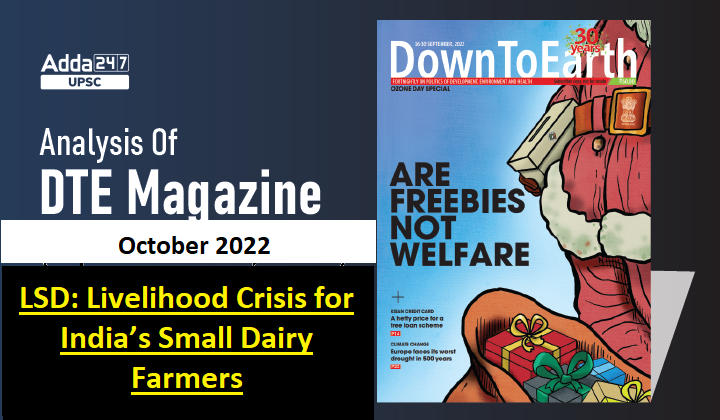Table of Contents
Introduction
- According to FAO and the World Organisation for Animal Health (WOAH), the spread of LSD can lead to “substantial” and “severe” economic losses.
- In India, the dependency on livestock for their income is more among marginal farmers.
- Livestock share in total farm income in India is higher among smallholders and even more than the cultivation of crops for marginal farmers.
- According to the Situation Assessment of Agricultural Households and Land and Livestock Holdings of Households in Rural India, 2019 prepared by the National Statistical Office, 10.9 per cent of those having 0.01 ha of land are engaged in livestock production, as opposed to 1.2 per cent and 0.8 per cent of those having 4-10 ha of land and above 10 ha land respectively.
.
What is Lumpy Skin Disease (LSD)?
- Lumpy skin disease (LSD) is caused by lumpy skin disease virus (LSDV), a virus from the family Poxviridae, genus Capripoxvirus. Sheeppox virus and goatpox virus are the two other virus species in this genus.
- LSDV is highly host specific and causes disease only in cattle (Bos indicus and B. taurus) and water buffalo (Bubalus bubalis).
- LSDV is not zoonotic, so humans cannot get affected by the disease.
- The disease is characterized by viremia, nodules on the skin, sit-fast formation, weight loss, emaciation, and reduction in milk and meat production.
- Transmission occurs in a wide variety of biotypes, from semi-desert to temperate grasslands and irrigated land. It has the potential to extend its range further.
- The morbidity rates for LSD during outbreaks vary between 10 and 20% although it has been reported in some places to be as high as 45%, and mortality rates of 1 to 5% are considered usual.
Economic impacts of LSD
- The disease leads to reduced milk production as the animal becomes weak and also loses appetite due to mouth ulceration. The income losses can also be due to poor growth, reduced draught power capacity and reproductive problems associated with abortions, infertility and lack of semen for artificial insemination.
- A risk assessment study conducted by the FAO based on information available from 2019 to October 2020 revealed that the economic impact of LSD for South, East and Southeast Asian countries “was estimated to be up to $1.45 billion in direct losses of livestock and production”.
- The current outbreak in India has emerged as a challenge for the dairy sector. India is the world’s largest milk producer at about 210 million tonnes annually. India also has the largest headcount of cattle and buffalo worldwide.
Livestock farming is the mainstay for Farmers
- Livestock farming is the mainstay for most of India’s poorest farmers, especially in arid and semi-arid regions. The sector contributed 4.35 per cent of total gross value added in 2019-20.
- It acts as an insurance during environmental stresses and has been more dependable than crops, especially for small and marginal farmers.
- Small and marginal farmers (who have less than two hectares (ha) of land) have a higher share in livestock farming than their medium and large counterparts.
How to control LSD?
- Successful control and eradication of LSD relies on early detection of the index case, followed by a rapid and widespread vaccination campaign.
- It is unlikely that total stamping-out (killing all clinically affected cattle and unaffected herd-mates) and partial stamping-out (killing only clinically affected cattle) alone, in the absence of vaccination, can eradicate LSD.
- There is no known carrier state. Once an animal has recovered, it is well protected and cannot be the source of infection for other animals.
- In infected animals that do not show clinical signs, the virus may remain in the blood for a few weeks and eventually disappear.



 TSPSC Group 1 Question Paper 2024, Downl...
TSPSC Group 1 Question Paper 2024, Downl...
 TSPSC Group 1 Answer key 2024 Out, Downl...
TSPSC Group 1 Answer key 2024 Out, Downl...
 UPSC Prelims 2024 Question Paper, Downlo...
UPSC Prelims 2024 Question Paper, Downlo...
